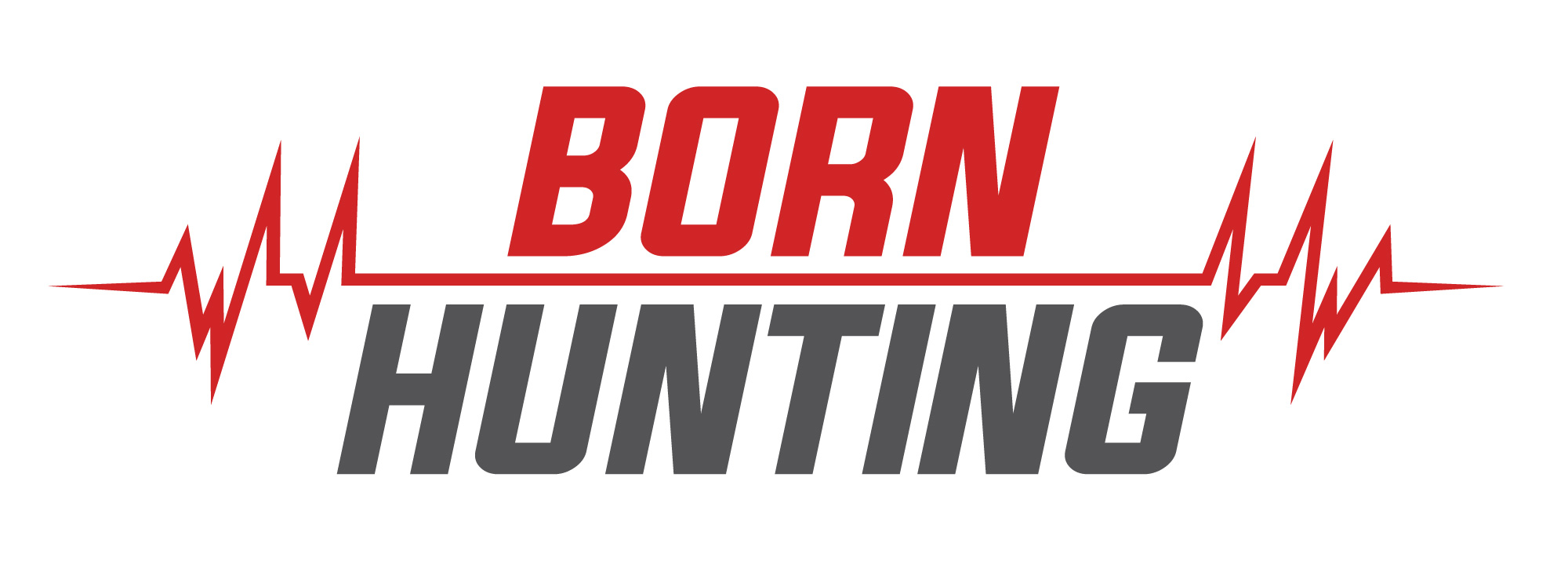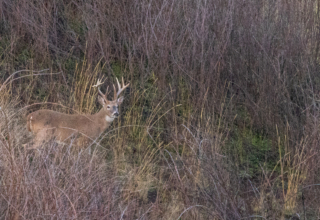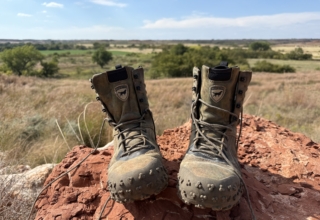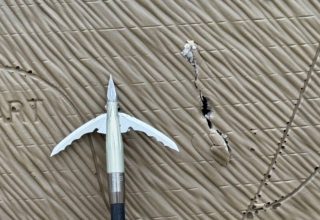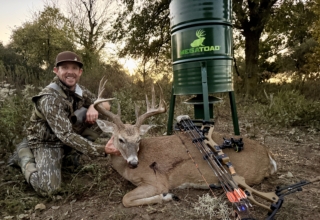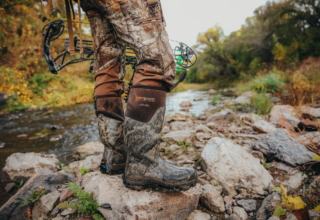When it applies to year-round hunting for invasive species, Texas is a land of opportunity. I suggest you take advantage.
by Jace Bauserman
Between 1957 and 1958, Texas Wildlife officials released roughly 40 aoudad into the state’s Palo Duro Canyon. It became apparent to the Texas Parks & Wildlife Department that the aoudad was bigger, stronger, more disease-resistant, and required less water than the bighorn. Not to mention aoudad reproduce rapidly. A ewe will typically throw twins, but triplets are not uncommon. The Texas population started to boom.
With desert bighorn numbers below 1,600 animals, according to a 2018 population census, and aoudad on the rise, many Texas ranchers have issued a shoot-on-site order for the labeled “invasive” species. For this reason, I was able to head south and chase a dream.
Texas Do-Dads
“They are the red-headed stepchild of the sheep world,” said Louisiana hunter Dr. Charlie Black. “What an incredible animal, but most ranchers despise their existence. This is domestic sheep and goat country, and aoudads compete for prime food sources and will even try to breed domestic ewes. They are also hard on fences and will, if they are in the area, visit a deer feeder. This doesn’t make those who lease land for prime whitetail hunting happy.”
Black was the man—a Doctor of Emergency Medicine—and had traveled the world for work and play. He’d darted rhinos in the Dark Continent, taken the Grand Slam of North American Wild Sheep, and harvested throngs of world-class whitetail. Black was at the lodge looking for a mature axis. Like me, he was an invitee, simply enjoying his time in God’s country. While Black hunted with lease members for axis, my friends and I hit the steep, shale-littered hills in search of what many of the lease members called “do-dads.”
My connection to the hunt was a lessee named Jeremiah Johnson. Johnson and I played youth sports together and had stayed in touch over the years. Johnson’s cousin, who had been to the ranch twice before, happened to be my best friend, and he’d strongly lobbied for my position on the hunt.
I’d never looked at an aoudad, but we had roughly 8,000 acres of free-range dirt to roam, and I was in good company. My buddy, Jason Weaver, is one of the best woodsmen I know. He has a knack for finding and getting close to game. Plus, he’d killed a pair of aoudads off the ranch — a respectable ram and ewe — on a past hunt.
The plan was simple. Jeremiah and his brother JD would work the west half of the ranch, and Jason and I would go east. I was chomping at the bit. The sun crawled over the eastern plateaus, and I was ready to go.
“No hurry,” Jason said. “We will be spending a lot of time behind the glass. These things have a reddish coat that blends well with these desert walls. When the sun is hitting the faces of the slopes, the sheep are a lot easier to see.”
I was on edge. My hands were sweaty, and my heart thundered. Jason would stop the side-by-side every few hundred yards, and we would glass. I spotted domestic sheep, a few rocks I swore had legs, and a handful of deer. No aoudad. The radio would scramble every so often, and my heart would race. The plan was for Jerimiah and JD to radio us if they found a herd, or anger, as they’re called. Each report, though, confirmed zero sightings.

We stayed out all day. We hiked to vantage points and took long strolls across boulder-covered plateaus. Our spotters and binos were used and abused, but neither party spied rams or any aoudad. As we went, we continued dropping pins on our HuntStand Apps. When you drop pins and track the dirt you’ve covered, you obtain more data and more date means improved analytics.
Exhausted, Jason and I decided to retreat to the valley floor and overlook a vast mesquite flat we’d scouted earlier in the day. The flat was rich with hog sign, and we sweetened the pot by adding a few bags of feed to the landscape. Plus, the locale would provide a 360-degree view of the surrounding hills.

We hadn’t been sitting down for three minutes when Jason whispered, “Well, I found your ram.”
I figured he was joking, but I should’ve known better. We’d hunted countless days together, and Jason never jokes when it comes to a sighting.
He was big and beautiful, with long reddish/orange hair spiraling down from his throat to the upper part of his legs. His horns were impressive, curving out and backward before turning inward again. He looked heavy.
Send It!
There were two problems. One: the ram was over a mile away, and we had just over an hour of light left. Two: he had the upper ground. Aoudad have large eyes compared to their body size, and their vision is exceptional; something to keep in mind when hunting these rock dwellers. We would have to use cedars and rocks to disguise our approach. We got aggressive — too aggressive. We’d closed on the ram quickly, relying on the cover, shadows, and a little luck. A stop-to-glass moment proved luck wasn’t on our side. The ram had gone up and over the caprock and out of sight.
We scoured the hill for 15 minutes with our binoculars. Nothing. Then, the man upstairs smiled at us. The ram eased back over the top of the ridge, and he was closer. The sun was setting, and we were pinned down. The shot would be longer than I’d hoped, but I knew the Kimber .280 Ackley Imp. topped with a dial-to-the-yard Leupold VX-5HD would put my Federal Terminal Ascent ammo on the mark if just breathed and squeezed.
Jason helped with the prep work. I had not one but two Primos Trigger Sticks under my rifle. The platform felt great, and the wind was nil. When Jason called out the 523-yard range, the Kimber barked.
“Miss,” was the report from Jason.
The ram darted to his left, stopped, and I cut another one loose. It was apparent the 165-grain bullet found its mark this time. The ram rocked, stumbled, and then bounded into the brush. We watched. He didn’t come out.
For A Full Review Of Kimber’s Mountain Ascent Click Here
Are You Sure?
Jason was confident the ram was down. I was a train wreck. Not only had I just made my longest shot ever (at the time), but I’d put a bullet into an animal I dreamt of chasing since I was a kid. And, as usual, Jason was right. The ram was stone dead.

Oddly enough, time seemed to slow. The western sky didn’t swallow the sun. When we reached the opposite side of the canyon, there was still enough light to take some photos, hug, and retell the tale before breaking out our headlamps.
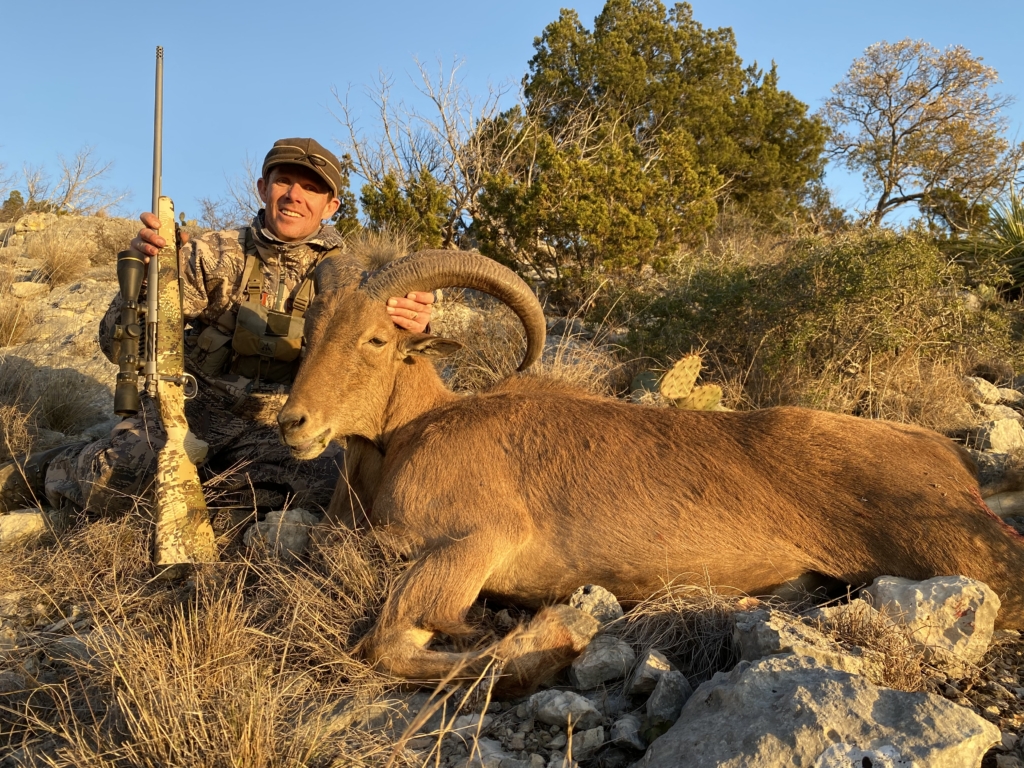
We packed meat, hide, and horns late into the night, but as is always the case, this part of the hunt is a true labor of love and something I truly live for.

Not Done Yet
We still had a few days to hunt, and with the ranch owner and the lessees wanting more do-dads in the cooler, we got back after it. I was thrilled that our day two aoudad hunt was interrupted, however. The ranch manager and the lessees gave Jason the green light to harvest an axis doe. Jason loves axis. From our day-two glassing point, we spied a lone axis doe slipping through the dry riverbed. Jason got prone, and at 423 yards, made a 12-ring shot with his 28 Nosler.

The morning was spent packing meat, and that evening, we opted to post up in a shooting house overlooking a solid hog area. No swine showed, but a pair of javelina did wander into range in the fading hours of the day. What a hunt it was shaping up to be. Long story short, Jason killed, I didn’t. Make a 523-yard shot and then screw the pooch at 125. Yikes! My pride was hurt, but my spirit was soaring. Three big-game animals on the ground in two days, sharing each moment with a good buddy and reminiscing around a campfire at night with a group of amazing men was hard to beat.
Lots of Aoudad
We had a giant ram in the spotter by 8:30 a.m. on day three. By 9 a.m., the ram had crossed a rock face and joined up with 26 other sheep—ewes, kids, young rams, and a few other bruisers.
After watching the anger of sheep for over an hour and waiting for the morning thermals to stabilize, I made my way up and around them. I planned to reach a distant ridge that would put the bulk of the grazing and bedded aoudad within 300 yards. Jason would stay in the valley below and keep the sheep in the lens of the spotter while I made my approach. Once I got eyes on them, I would signal Jason to come up.
These sheep move a lot. Aoudad bed and stand, and graze and walk. I was surprised at how quickly they could move; keeping them in the glass is always a good idea. They are ghosts and can disappear in an instant.
That was the longest wait of my life. Three big rams bedded directly under me but had moved off when Jason made the mile trek up the hill. The wind had shifted slightly, and I’m certain the rams got a slight whiff of my human stink. Still, there were plenty of sheep in range, and our target ram, one we’d named Gimpy because of a noticeable limp, was standing broadside across the canyon at 300 yards.
We were both on our sticks. Jason would shoot first, and then I would find a large ewe and take my shot. It was perfect. That is, until Jason’s gun sang. My shot was accurate, and my 270 Win. Short Magnum crumbled a ewe. Gimpy, however, was still on his feet. Jason emptied his gun and then looked at me in disbelief. I was as shocked as he was. I’d seen him shoot a pile of game over the years, and he rarely misses.

On the walk to recover my ewe, Jason discovered he didn’t return his scope dial to zero. He was still dialed in from his distant axis shot and sent lead over the top of Gimpy. That one stung a little, but being the man he is, Jason was elated I’d taken my second aoudad. We received word that Jeremiah had killed a ewe that morning as well.

It doesn’t get much better—huntable ground, aoudad, and a crew of good friends making dreams come true on the famed Edwards Plateau.
Why Not You?
It’s true. An outfitted aoudad hunt will run you between $5-$8K. That’s out of my price range. However, with many Texas ranchers and those leasing these ranches wanting aoudad shot on sight, your Texas sheep dream could become reality if you’re willing to research.
I got lucky; I agree. With that noted, a little time on Craigslist, Facebook, and Instagram may put you in the chips. A quick Craigslist search revealed more than a few Texas leases selling reduced-priced aoudad hunts. Also, those willing to strike up a conversation on social media and arrange a hunt swap could easily find their way onto aoudad-rich ground.
Texas isn’t known as a great public-land destination, but a glance at Texas Parks and Wildifle could change your opinion. The state has over 1 million acres of open-to-anyone dirt, and taking a public-land aoudad is very possible.
